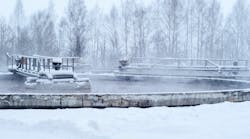State water experts warn that if drought persists another 18 months, Lake Powell could dip so low that states along the Colorado River, including Colorado, would be asked to use less water, the Rocky Mountain News reported.
At only 10.4 million acre-feet at the end of June, Lake Powell is the lowest it's been since 1980 in comparison to 24 million acre-feet when full.
According to Scott Balcomb, a Glenwood Springs attorney and Colorado's representative on the seven-state Colorado River Commission, the lake's water levels could sink below Glen Canyon Dam's turbines, which supply part of the West's power.
The Colorado River waters the West. Flows are divided in half between the upper basin states–Colorado, Wyoming, New Mexico and Utah–and the lower basin states of Arizona, Nevada and California. The river commission manages the shared water, the Rocky Mountain News reported.
Balcomb said that the upper basin states use their legal share, but could be asked to give up water to raise Lake Powell. For Colorado, the sacrifice could affect farmers, ranchers and towns, mostly on the Western Slope.
Arizona, California and Nevada–all downstream of Lake Powell could be asked to conserve the water released from Lake Powell, Balcomb added.
"The Colorado River system has been in surplus so long, we haven't looked at what to do in a long drought," Balcomb said. "Everything has changed. We need to encourage the lower basin states to look at curtailing the waste."
According to him, during the drought, Arizona should reduce pumping river water into underground aquifers for future development.
Balcomb said that farmers in California often waste water when they request a release from a reservoir, which could take several days to arrive; however, rains often arrive before the reservoir water is delivered and the reservoir water flows unused in Mexico. The unused Colorado River water is not counted against California's allocation, but effectively lowers Lake Powell, he explained.
"We need to encourage them to not waste water," Balcomb said.
In addition, revenue from the sale of electricity generated at Glen Canyon Dam at Lake Powell, which pays for Colorado's endangered-fish recovery programs and helps repay federal water project costs is also at stake.
Rod Kuharich, director of the Colorado Water Conservation Board said that they are working hard on becoming more efficient in the lower basin so that the upper basin states including Colorado would benefit.
Source: Rocky Mountain News

